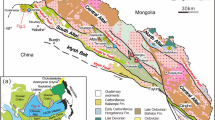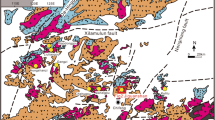Abstract
Mixing of metal-rich connate waters derived from evaporative seawater with local sulfide-rich water is postulated as the mechanism of ore deposition in many Phanerozoic carbonatehosted Pb-Zn deposits. The study of the Paleoproterozoic Balaria deposit of the Zawar belt of Rajasthan that hosts structurallycontrolled, stratabound Pb-Zn mineralization, provides insight into the nature of fluids in quartz that is closely associated with massive Pb-Zn ore.
The present study is focused on the massive-type ore which forms one of the major ore-types at Balaria. Massive-type ore consists predominantly of galena and sphalerite (with minor pyrite and pyrrhotite) that occur in shear-induced dilatational fractures. The ore is associated with clear, rounded to semi-rounded bodies of quartz that are embedded within the ore. The quartz bodies are inferred to be fragments of vein-quartz that underwent shear deformation along with enclosing massive galena-rich ore. Primarybiphase fluid inclusions in quartz belong to H2O-NaCl±CO2, H2ONaCl- CH4-N2-CO2 and primary-monophase fluid inclusions to CH4-N2-CO2 types, while secondary fluid inclusions are biphase and belong to H2O-NaCl type. The salinity of primary-biphase H2O-NaCl type fluid inclusions range from 2 to 14 wt. percent NaCl equiv while that of secondary-biphase H2O-NaCl type fluid inclusions range from 3 to 5 wt. percent NaCl equiv. Homogenization temperatures for primary-biphase fluid inclusions range from 127o to 217oC while that of secondary-biphase fluid inclusions is 131o to 151oC. The molecular proportions of of CH4, N2 and CO2 in primary-biphase (H2O-NaCl-CH4-N2-CO2) and primary-monophase (CH4-N2-CO2) as measured from Raman spectra are widely variable. Variability in molecular proportions of CH4, N2 and CO2 is interpreted as an evidence for mixing of pulses of a regional fluid with a local fluid and reactions with graphitic and carbonate rocks at the site of deposition. The low salinity of fluid inclusions in the quartz and the lack of any sulfur species in the aqueous or gaseous phase of the entrapped fluids indicates that although quartz occurs as entrained bodies within the massive ore, the fluids in them may not represent ore-forming fluids of the main ore-stage of massive-type ore.
Similar content being viewed by others
References
Appold, M.S. and Wenz, Z.J. (2011) Composition of fluid inclusions from the Viburnum Trend, Southeast Missouri district, United States: Implications for transport and precipitation mechanisms. Econ. Geol., v.106, pp.55–78.
Basuki, N.I. and Spooner, E.T.C. (2004) A review of fluid inclusion temperatures and salinities in Mississippi Valley-type Zn-Pb deposits: Identifying thresholds for metal transport. Exploration and Mining Geology, v.11(1-4), pp.1–17.
Bhattacharya, H.N. and Bull, S. (2010) Tectono-sedimentary setting of the Paleoproterozoic Zawar Pb–Zn deposits, Rajasthan, India. Precambrian Res., v.177(3), pp.323–338.
Bodnar, R.J. (1993) Revised equation and table for determining the freezing point depression of H2O-NaCl solutions. Geochim. Cosmochim. Acta, v.57, pp.683–684.
Burke, E.A.J. (1995) Raman microspectrometry of fluid inclusions: The daily practice. In: de Vivo, B., Frezzotti, M.L. (Eds.), Fluid inclusions in minerals: Methods and applications, short course of the working group IMA. Virginia Polytechnic Institute and State University, USA, pp.25–44.
Burke, E.A.J. (2001) Raman microspectrometry of fluid inclusions. Lithos, v.55, pp.139–158.
Chauhan, D.S., 1970. Some evidences about synsedimentary nature of leadzinc-pyrite deposits of Zawar. Jour Mines Metals Fuels, v.18, pp.81–85.
Chauhan, D.S. (1974) Diagenetic pyrite from the lead-zinc deposits of Zawar, India. Mineralium Deposita, v.9(1), pp.69–73.
Conliffe, J., Wilton, D.H.C., Blamey, N.J.F. and Archibald, S.M. (2013) Paleoproterozoic Mississippi Valley Type Pb–Zn mineralization in the Ramah Group, Northern Labrador: Stable isotope, fluid inclusion and quantitative fluid inclusion gas analyses. Chemical Geol., v.362, pp.211–223.
Deb, M., Thorpe, R.I., Cumming, G.L. and Wagner, P.A. (1989) Age source and stratigraphic implications of Pb isotope data for conformable, sediment hosted base metal deposits in the Proterozoic Aravalli Delhi orogenic belt, northwestern India: Precambrian Res., v.43, pp.1–22.
Farquhar, J., Wu, N.P., Canfield, D.E., and Oduro, H. (2010) Connections between sulfur cycle evolution, sulfur isotopes, sediments and basemetal VMS, SEDEX, and MVT deposits. Econ. Geol., v.105, pp.509–533.
Gupta, S.N., Arora, Y.K., Mathur, R.K., Iqbaluddin, Prasad, B., Sahai, T.N., and Singh, S.B. (1980) Lithostratigraphic map of Aravalli region, Southern Rajasthan and Northern Gujarat. Geol. Surv. India Publication, Hyderabad.
Haynes, F.M., Beane, R.E. and Kesler, S.E. (1989) Simultaneous transport of metal and reduced sulfur, Mascot-Jefferson City zinc district, East Tennessee; evidence from fluid inclusions. Amer. Jour. Sci., v.289(8), pp.994–1038.
Hedenquist, J.W. and Henley, R.W. (1985) The importance of CO2 on freezing point measurements of fluid inclusions; evidence from active geothermal systems and implications for epithermal ore deposition. Econ. Geol., v.80(5), pp.1379–1406.
Heron, A.M. (1953) The Geology of Central Rajputhana. Geol. Surv. India Mem., v.79(1), 389p.
Huizenga, J.M., Gutzmer, J., Banks, D. and Greyling, L. (2006) The Paleoproterozoic carbonate-hosted Pering Zn–Pb deposit, South Africa. II: fluid inclusion, fluid chemistry and stable isotope constraints. Mineralium Deposita, v.40(6-7), p.686.
Hurai, V., Huraiová, M., Slobodník, M. and Thomas, R. (2015) Geofluids: Developments in Microthermometry, Spectroscopy, Thermodynamics, and Stable Isotopes. Chap.7, p.231–279, Elsevier.
Jackson, S.A., and Beales, F.W. (1967) An aspect of sedimentary basin evolution: The concentration of Mississippi Valley-type ores during late stage of diagenesis. Canadian Petroleum Geol. Bull., v.15, pp.383–433.
Jones, H.D. and Kesler, S.E. (1992) Fluid inclusion gas chemistry in east Tennessee Mississippi Valley-type districts: evidence for immiscibility and implications for depositional mechanisms. Geochim. Cosmochim. Acta, v.56(1), pp.137–154.
Kesler, S.E., and Reich, M. (2006) Precambrian Mississippi Valley-type deposits: Relations to changes in the atmosphere and hydrosphere. In: Kesler, S.E., and Ohmoto, H., (eds.) Evolution of Early Earth’s Atmosphere, Hydrosphere and Biosphere-Constraints from Ore deposits. Geol. Soc. Amer. Mem., v.198, pp.185–204.
Kesler, S.E., and Reich, M., and Jean, M. (2007) Geochemistry of fluid inclusion brines from Earth’s oldest Mississippi Valley-type (MVT) deposits, Transvaal Supergroup, South Africa. Chemical Geol., v.237, p.274–288.
Leach, D.L, Sangster, D.F., Kelley, K.D., Large, R., Garven, G., Allen, C.R., Gutzmer, J., and Walters, S. (2005) Sedimenthosted lead-zinc deposits: A global perspective. In: Hedenquist, J.W., Thompson, J.F.H., Goldfarb, R.J., and Richards, J.P., (Eds.), Econ. Geol., 100th Anniversary Volume, 1905-2005, pp.561–607.
Leach, D.L., and Sangster, D.F. (1993) Mississippi Valley-type lead-zinc deposits. In: Kirkham, R.V., Sinclair, W.D., Thorpe, R.I., and Duke, J.M., (Eds.), Mineral Deposit Modeling, Geological Association of Canada Special Paper 40, pp.289–314.
Leach, D.L., Bradley, D.C., Huston, D., Pisarevsky, S.A., Taylor, R.D. and Gardoll, S.J. (2010) Sediment-hosted lead-zinc deposits in Earth history. Econ. Geol., v.105(3), pp.593–625.
Leach, D.L., Taylor, R.D., Fey, D.L., Diehl, S.F., and Saltus, R.W. (2010) A deposit model for Mississippi Valley-type lead-zinc ores: Chapter A of mineral deposit models for resource assessment. US Gelogical Survey Scientific Investigation Report, 2010-5070-A.
Lowenstein, T.K., Hardie, L.A., Timofeeff, M.N., and Demicco, R.V. (2003) Secular variation in seawater chemistry and the origin of calcium chloride basinal brines. Geology, v.31, pp.857–860.
Mookherjee, A. (1964) The geology of the Zawar lead-zinc mine, Rajasthan, India. Econ. Geol., v.59(4), pp.656–677.
Mukherjee, A.D. and Sen, R.N. (1980) Geochemical implications in the genesis of Zawar lead-zinc deposit, Rajasthan, India. In Proceedings Fifth IAGOD Symposium, v.1, pp.709–718.
Pandalai, H.S., Nevin, C.G. and Dona G. (2008) Variations in C-O-H-N fluid chemistry in the Proterozoic carbonate-hosted Pb-Zn Zawar group of deposits. Presented at ACROFI-II, IIT Kharagpur, 12-14 Nov 2008. Abstract volume Eds. Panigrahi, M.K. Proceedings of the Second meeting of second meeting of ACROFI, IIT Karagpur, pp.140–143.
Pereira, J. (1964) Zawar lead-zinc mine; hypogene-hydrothermal or remobilized?. Econ. Geol., v.59(8), pp.1603–1604.
Poddar, B.C. (1965) Lead-zinc mineralization in the Zawar belt, India. Econ. Geol., v.60(3), pp.636–638.
Roy, A.B. (1988) Stratigraphic and tectonic framework of the Aravalli Mountain Range. Precambrian of the Aravalli Mountain, Rajasthan, India. Geol. Soc. India Mem., no.7, pp.3–31.
Roy, A.B. (1995) Geometry and evolution of superposed folding in the Zawar Pb-Zn mineralized belt, Rajasthan, India. Proc. Indian Acad. Sci. (Earth Planet. Sci.), v.104, pp.349–371.
Sangster, D.F. (1990) Mississippi Valley-type and SEDEX lead-zinc deposits; a comparative examination. Transactions, Institute of Mining and Metallurgy, Section B 99: B21–B42.
Sharma, R.S. (1988) Patterns of metamorphism in the Precambrian rocks of the Aravalli mountain belt. Geol. Soc. India Mem., no.7, pp.33–75.
Shepherd, T.J., Rankin, A.H., and Alderton, D.H. (1985) A practical guide to fluid inclusion studies, Glasgow, Blackie and Son, 239p.
Singh, N.N. (1988) Tectonic and stratigraphic framework of the lead-zinc sulphide mineralization at Zawarmala, district Udaipur, Rajasthan. Jour. Geol. Soc. India, v.31, p.546–564.
Sinha-Roy, S. (1988) Proterozoic Wilson cycles in Rajasthan, NW India. In: A.B. Roy (eds.), Precambrian of the Aravalli mountain range. Geol. Soc. India Mem., v.7, pp.95–108.
Smith, A.W. (1964) Remobilization of sulfide orebodies [discussion]. Econ. Geol., 59(5), pp.930–935.
Stoffell, B., Appold, M.S., Wilkinson, J.J., McClean, N.A. and Jeffries, T.E. (2008) Geochemistry and evolution of Mississippi Valley-type mineralizing brines from the Tri-State and northern Arkansas districts determined by LA-ICP-MS microanalysis of fluid inclusions. Econ. Geol., 103(7), pp.1411–1435.
Sverjensky, D.A. (1984) Oil field brines as ore-forming solutions. Econ. Geol., v.79(1), pp.23–37.
Sverjensky, D.A. (1986) Genesis of Mississippi Valley-Type Lead-Zinc Desposits. Annual Rev. Earth Planet. Sci., v.14(1), pp.177–199.
Talluri, J.K., Pandalai, H.S., and Jadhav, G.N. (2000) Fluid Chemistry and Depositional Mechanism of the Epigenetic, discordant ores of the Proterozoic, Carbonate hosted Zawarmala Pb-Zn Deposits, Udaipur district, India. Econ. Geol., v.95, pp.1505–1525.
Vidyarthi, R.C., and Sen, R. (1978) Baroi-Zawarmala lead-zinc deposits, Zawar belt, Udaipur, Rajasthan, India; a tectonic and metallogenic appraisal: Geol. Surv. India Misc. Publ., no.34, pp.118–134.
Wenz, Z.J., Appold, M.S., Shelton, K.L., and Tesfaye, S. (2012) Geochemistry of Mississippi Valley-type mineralizing fluids of the Ozark Plateau: A regional synthesis. Amer. Jour. Sci., v.312, pp.22–80.
Wilkinson, J.J. (2014) Sediment-Hosted Zinc-Lead Mineralization: Processes and Perspective. Treatise on Geochemistry (Second Edition), v.13.9, pp.219–249.
Author information
Authors and Affiliations
Corresponding author
Rights and permissions
About this article
Cite this article
Ilyas, M., Pandalai, H.S. Fluid inclusion studies on quartz associated with massive ores of the Paleoproterozoic carbonate-hosted Pb-Zn deposit at Balaria, Rajasthan: Possible evidence for fluid-mixing. J Geol Soc India 90, 577–585 (2017). https://doi.org/10.1007/s12594-017-0754-0
Published:
Issue Date:
DOI: https://doi.org/10.1007/s12594-017-0754-0




